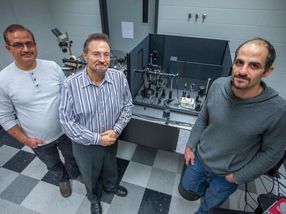Researchers aim to develop new techniques for creating high-temperature alloys
North Carolina State University is taking the lead in a new initiative aimed at addressing fundamental scientific questions that could lead to the development of so-called "entropy-stabilized alloys" that can withstand extremely high temperatures. The initiative includes Duke University, the University of Virginia, and the University of California, San Diego, and is funded by a five-year, $8.4 million grant from the Office of Naval Research (ONR).
"The Defense Department has a need for materials that are mechanically and chemically stable at ultra-high temperatures - meaning temperatures of 2,000 degrees Celsius or more," says Don Brenner, Kobe Steel Distinguished Professor of Materials Science and Engineering at NC State and principal investigator under the ONR grant. "These materials can have significant aerospace applications, but the number of usable materials is currently small, and those materials rely on strong chemical bonding to remain stable. At high temperatures, most materials are simply no longer stable."
To address the shortage of ultra-high temperature materials, ONR has tasked Brenner and the rest of the research team with investigating the viability of creating entropy-stabilized alloys that withstand these temperatures. Entropy-stabilized alloys are materials that consist of four or more elements in approximately equal amounts, and they have garnered significant attention in recent years because they can have remarkable properties. These alloys are of interest for use in ultra-high temperature applications because of their unique ability to "absorb" disorder in a material's crystalline structure that otherwise would lead to the breakdown of a material.
As the temperature of a crystal is increased, it begins to lose its ordering. That means that individual atoms may move around. And when those atoms get rearranged, it can affect the structure - one of the cubes might start changing into a different shape. This can occur in different ways, such as distortions of the lattice or atoms missing from their lattice sites. At high enough temperatures this disordering can lead to melting, or otherwise cause a material to lose strength.
But in entropy-stabilized alloys, the mix of elements can be arranged in many different ways on a single lattice type. In other words, the structure can continue to be a series of cubes, even if the elements that make up the structure get shuffled around. Researchers think this ability to retain its structural integrity even when the atoms become disordered has the potential to increase melting points and make materials useful at ultra-high temperatures.
"We'll be developing new experimental approaches for evaluating high-entropy alloys at ultra-high temperatures," Brenner says. "For example, how do you test an alloy if the equipment containing the alloy melts before the alloy does? And how can we evaluate whether a material will oxidize at extreme temperatures, thus altering the material's properties?"
"After good candidate materials are established, we will work to synthesize, process and test bulk samples," Brenner says. "However, our work is not aimed at necessarily creating new materials, but rather introducing new theoretical, computational and experimental tools into the larger ultra-high temperature materials community.
"It's also important to stress that all of this work is truly interinstitutional, drawing on expertise from all of the parties involved," Brenner says.
"Researchers from Lockheed-Martin, the Naval Air Weapons Station at China Lake, the Air Force Research Laboratory, and the Naval Research Laboratory, together with other DoD-related laboratories will help to advise our work, especially in terms of DoD and civilian needs," Brenner says.
Other news from the department science

Get the chemical industry in your inbox
By submitting this form you agree that LUMITOS AG will send you the newsletter(s) selected above by email. Your data will not be passed on to third parties. Your data will be stored and processed in accordance with our data protection regulations. LUMITOS may contact you by email for the purpose of advertising or market and opinion surveys. You can revoke your consent at any time without giving reasons to LUMITOS AG, Ernst-Augustin-Str. 2, 12489 Berlin, Germany or by e-mail at revoke@lumitos.com with effect for the future. In addition, each email contains a link to unsubscribe from the corresponding newsletter.

























































